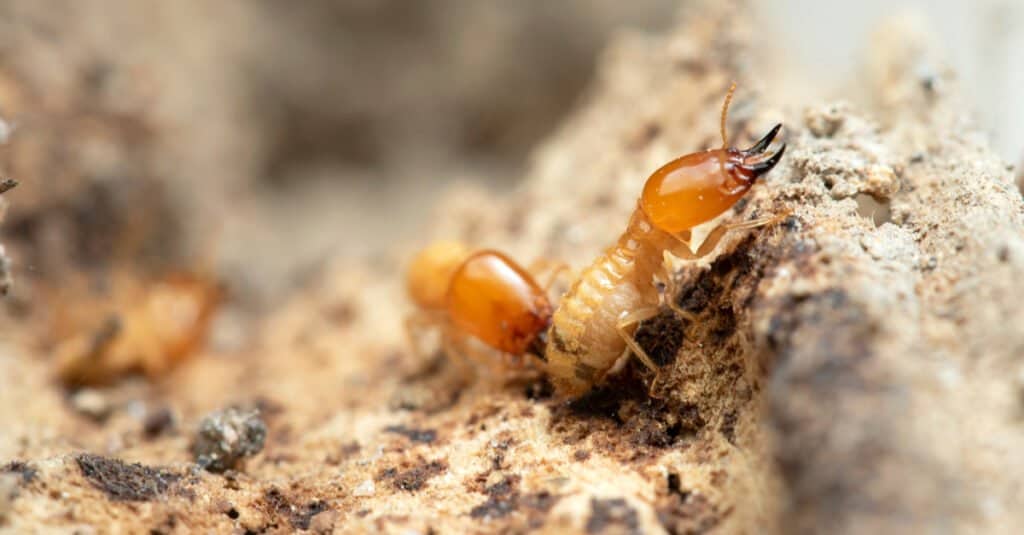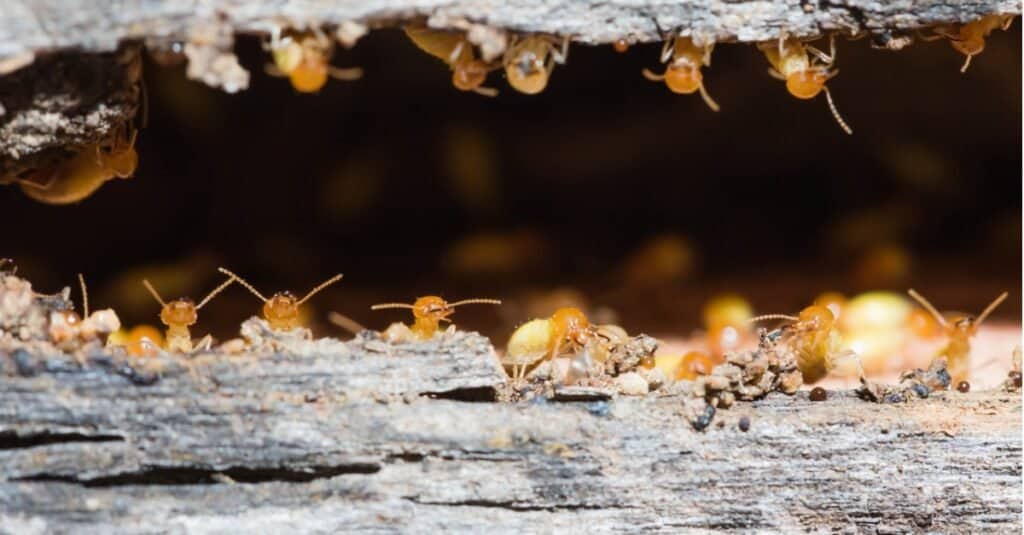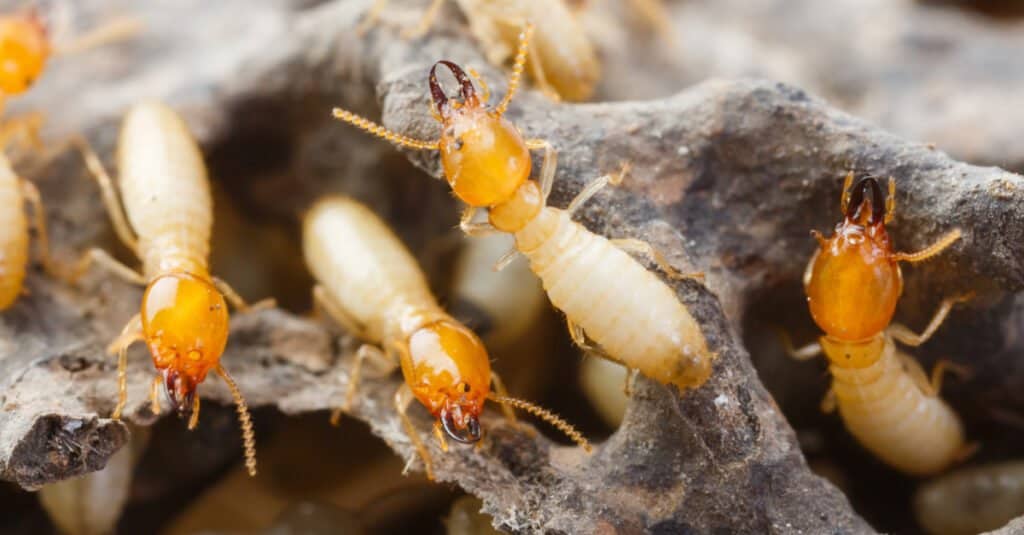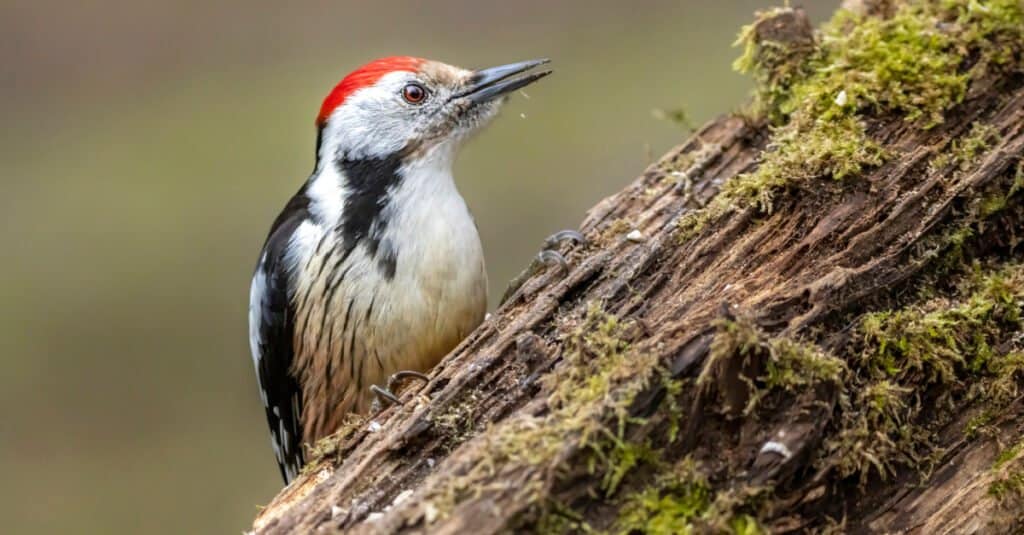Termites are small insects in the same family as cockroaches, but most people would prefer an infestation of the latter. These pests are known for being highly destructive to homes, often causing damage to wood structures with their feeding. So, what do termites eat? For that matter, how do they eat their food?
We’ll tell you everything you need to know including where they go when it gets cold outside. Depending on your location, you might not like the answer! Fortunately, we will also show you the predators that hunt these insects.
What Foods Do Termites Eat?

Termites are detritivores that eat wood, decaying plants, and fungi.
©bamgraphy/Shutterstock.com
Termites eat dead or dying plants, wood, roots, and fungi. They are considered detritivores, creatures that consume debris that is considered detritus. These insects specifically target foods for their cellulose content. Their unique gut bacteria allow them to break down cellulose and gain energy from it.
Here are the most common foods that termites eat:
- Grasses
- Fungi (Termitomyces and Xylaria in particular)
- Mango trees
- Peach trees
- Pine trees
- Mulch
- Sugarcane
- Springwood
- Roots
- Oaks trees
- Ash trees
- Termite feces
- Cotton
- Palm trees
Termites will feed on plant matter and wood that is in a state of decay where they can easily harvest the food and digest it. As one might imagine, the termite’s diet is a big problem for human beings because wood is a common building material. An infestation of termites can become so severe that the individuals must leave a home because of structural damage.
Some other parts of the termite diet are more utilitarian. Termites will often eat feces to help prepare their gut bacteria for digestion; their bodies do not naturally possess the bacteria and enzymes required to digest the tough plant matter and fungi. Eating other termites’ feces prepare their bodies.
Termites’ diet and ability to recycle their waste to construct their homes make these insects a valuable creature in their ecosystem, ensuring that waste products are used instead of merely piling up.
Unfortunately, it is currently believed that termites’ digestive processes result in the release of significant amounts of methane, upwards of 3% of global emissions. Even though their mounds mitigate the methane emissions, their eating habits could spell trouble of a greater magnitude for humans than half-eaten telephone poles.
How Do Termites Eat Their Food?

Termites use their strong mandibles and unique digestive systems to break down cellulose.
©iStock.com/chyball
Wood, plant matter, and fungi are not exactly easy for insects to eat and digest, but termites manage. Termites have special asymmetrical mandibles that allow them to tear into their preferred food and start consuming it quickly and efficiently.
Using their strong mouthparts, termites can rapidly chew and swallow their food so that their special gut biome can break down the cellulose into usable energy for the termite. Interestingly, not all termites in the caste system are capable of digesting cellulose; they’re tasked with different jobs.
Thus, it falls to the worker caste to feed other termites their meals, a process that is called trophallaxis. The workers will feed the other termites mouth-to-mouth or anus-to-mouth.
Another unique aspect of termites’ eating habits is that their symbiotic relationship with the Termitomyces fungi. Termites essentially grow these fungi in a fungus comb and allow them to mature within their mounds. The insects consume the fungi and use their enzymes to bolster their digestive capabilities, making it easier to break down cellulose.
Basically, termites are farmers for fungi that they use to aid their digestion.
What Competes with Termites for Food?

Termites have to compete for food with
beetles
while also dodging carpenter ants.
©Mr.Parichat chaikuad/Shutterstock.com
Although termites might be the most common insect that eats dying plant matter and wood, they do have some competition for their meals.
For example, Powderpost beetles are a competitor for wood that termites face. These beetles bore into wood and lay eggs. Their young hatch and eat their way to the top. Unlike termites, these insects are primarily found indoors, especially in flooring planks and furniture.
Sometimes, the competition with termites is more about limiting the insect’s foraging efforts and less about eating the same food source. For example, carpenter ants often burrow into wood to create nests for their offspring.
Both carpenter ants and termites seek rotting wood. When the two meet, the ants will often kill and eat the termites, sometimes wiping out an entire colony along the way.
Bark beetles are another bug that consumes wood and thereby competes with termites for food. They can often be found below the bark of trees, eating dry woods.
Some of these competitors are dangerous, like the ants, but others just leave less wood for termites even if their ranges do not overlap entirely.
What Do Termites Eat During Winter?

During the winter, termites eat wood and other decaying plant matter.
©7th Son Studio/Shutterstock.com
Termites are very determined creatures, but they are also cold-blooded. That means they need to find shelter in the winter, or they die off. Although some termites are killed off by the cold, others continue to dig into the ground in search of roots and decaying plant matter.
If the temperature is warm enough, termites will leave their nest, gather food, and bring it back for the soldiers and breeding castes.
Of course, another option for termites is to find a nice warm home where humans live and continually feed off wood in out-of-the-way areas like basements.
Termites eat much of the same foods in winter as they do year-round, including decaying plant matter, wood, and fungi they have stored in their mounds.
What Predators Hunt Termites?

Woodpeckers will happily dig termites out of trees and eat them.
©iStock.com/SL
Although termites are numerous and capable of tearing into homes, they’re not exactly great at defending themselves. As we’ve already mentioned, carpenter ants can wipe out colonies of termites. Humans are not too fond of these insects, either.
Take a look at these termite predators:
- Lomamyia
- Carpenter ants
- Woodpeckers
- Lizards
- Bats
- Foxes
- Crickets
- Dragonflies
- Spiders
- Mice
- Snakes
- Bears
- Chimpanzees
- Humans
Termites are small creatures with a lot of enemies. Although humans do not eat termites, they certainly hunt them down and kill them to prevent damage to buildings.
Termites are detritivores that form interesting symbiotic relationships with fungi, protozoa, and bacteria to help them break down tough food materials like cellulose. Termites are all over the world, and humans can only estimate how many of them truly exist and the impacts they have.
While capable, termites are also susceptible to attacks by predators that hunt and feed on them as well as humans who are consistently fighting a battle to save structures from their destructive ways.
The photo featured at the top of this post is © PK289/Shutterstock.com
Thank you for reading! Have some feedback for us? Contact the AZ Animals editorial team.






